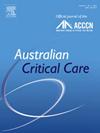Availability and use of indirect calorimetry in adult Australian and New Zealand intensive care units: A report using data from an observational study of nutrition practices
IF 2.7
3区 医学
Q2 CRITICAL CARE MEDICINE
引用次数: 0
Abstract
Background
Indirect calorimetry is recommended as the reference method for determining energy expenditure and guiding energy delivery in critical care nutrition practice guidelines. However, the availability and use of indirect calorimetry in Australian and New Zealand intensive care units (ICUs) is unknown.
Objectives
To report on the availability and use of indirect calorimetry in Australian and New Zealand ICUs.
Methods
A binational multicentre observational study of nutrition practices was conducted in adult ICUs over a 1-week period in February 2021. All adult ICUs were invited to participate via multiple forums. Participating sites completed a once-off form on hospital and nutrition services which included questions relating to the availability and frequency of use (daily, fortnightly, monthly, and do not use) of indirect calorimetry. Data were collected on the type of device used and barriers to use. Data are reported as n (%).
Results
Forty-four ICUs reported data on hospital and nutrition services. Indirect calorimetry was available in 13 of 44 sites (30%): 12 sites in Australia and one in New Zealand. The COSMED Quark RMR (6/13 [46%]) and Q-NRG+ (5/13 [38%]) devices were the most commonly available. Indirect calorimetry was most frequently used on a weekly (4/13 [31%]) or monthly basis (4/13 [31%]). One site (8%) reported using indirect calorimetry fortnightly, with the remaining sites (4/13 [31%]) reporting that they do not use indirect calorimetry due to a lack of training (1/4 [25%]), no funding for consumables and a lack of training (1/4 [25%]), and for reasons not further specified (2/4 [50%]).
Conclusions
In 2021, indirect calorimetry was available in 30% of ICUs across Australia and New Zealand. However, only one-third of sites used this technology weekly, with reasons limiting use including a lack of training and funding for consumables. Expanding dedicated training programs and improving funding models may help overcome these barriers.
Study registration
https://www.anzctr.org.au/.
Trial ID
ACTRN12620001025921.
间接量热法在澳大利亚和新西兰成人重症监护病房的可用性和使用:一份使用营养实践观察性研究数据的报告
在重症监护营养实践指南中,直接量热法被推荐作为确定能量消耗和指导能量输送的参考方法。然而,间接量热法在澳大利亚和新西兰重症监护病房(icu)的可用性和使用情况尚不清楚。目的报告澳大利亚和新西兰icu中间接量热法的可得性和使用情况。方法于2021年2月对成人icu患者进行为期1周的营养实践两国多中心观察性研究。通过多个论坛邀请所有成年icu参与。参与站点填写了一份关于医院和营养服务的一次性表格,其中包括与间接量热法的可用性和使用频率(每日、每两周、每月和不使用)有关的问题。收集了使用的设备类型和使用障碍的数据。数据以n(%)报告。结果44个icu报告了医院和营养服务数据。44个站点中的13个(30%)提供间接量热法:澳大利亚12个站点和新西兰1个站点。COSMED夸克RMR(6/13[46%])和Q-NRG+(5/13[38%])装置是最常用的。间接量热法最常用于每周(4/13[31%])或每月(4/13[31%])。一个站点(8%)报告每两周使用间接量热法,其余站点(4/13[31%])报告由于缺乏培训(1/4[25%]),没有资金购买消耗品和缺乏培训(1/4[25%])以及未进一步说明的原因(2/4[50%])而不使用间接量热法。结论2021年,澳大利亚和新西兰30%的icu采用了间接量热法。然而,只有三分之一的网站每周使用这种技术,原因包括缺乏培训和消耗品的资金。扩大专门的培训项目和改进资助模式可能有助于克服这些障碍。研究注册:https://www.anzctr.org.au/.Trial IDACTRN12620001025921。
本文章由计算机程序翻译,如有差异,请以英文原文为准。
求助全文
约1分钟内获得全文
求助全文
来源期刊

Australian Critical Care
NURSING-NURSING
CiteScore
4.90
自引率
9.10%
发文量
148
审稿时长
>12 weeks
期刊介绍:
Australian Critical Care is the official journal of the Australian College of Critical Care Nurses (ACCCN). It is a bi-monthly peer-reviewed journal, providing clinically relevant research, reviews and articles of interest to the critical care community. Australian Critical Care publishes peer-reviewed scholarly papers that report research findings, research-based reviews, discussion papers and commentaries which are of interest to an international readership of critical care practitioners, educators, administrators and researchers. Interprofessional articles are welcomed.
 求助内容:
求助内容: 应助结果提醒方式:
应助结果提醒方式:


